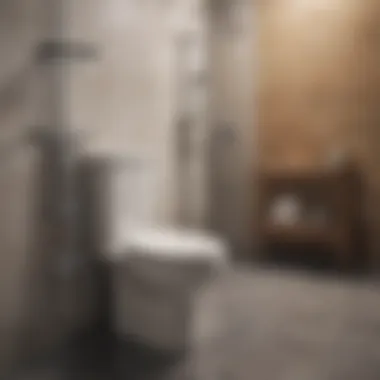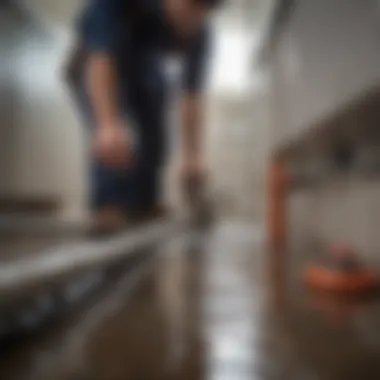Understanding Flush Toilets and Shower Drainage Issues


Intro
Plumbing systems in residential homes are intricate structures, often working together to ensure efficiency and functionality. One common concern for homeowners is the relationship between flush toilets and shower drainage. When water backs up in the shower after a toilet flush, it raises questions about plumbing health and home maintenance. Understanding the reasons behind this phenomenon is essential for homeowners and enthusiasts alike.
In this article, we will explore how these systems interact, pinpointing known issues that can lead to drainage problems. From the mechanics of these fixtures to solutions for common issues, our guide aims to provide clear insights into maintaining a harmonious living space. By the end, readers should feel equipped to address their plumbing concerns effectively and understand the implications of their plumbing choices on overall home performance.
Prologue to Plumbing Systems
Plumbing systems in residential settings serve a crucial role in providing safe water supply and efficient waste management. Understanding the components and mechanisms of these systems can facilitate better maintenance, preventing potential issues that can cause significant disruptions in our daily lives. In this article, we will explore how flush toilets impact shower drainage, shedding light on the interaction between these two essential fixtures.
The Basics of Residential Plumbing
Residential plumbing is fundamentally designed to transport water in and out of homes. This system allows clean water to enter facilities for various uses, including drinking, cooking, and bathing. Conversely, it ensures that wastewater is efficiently drained away from the household.
A typical plumbing setup includes water supply lines and drainage systems. Water supply lines are pressurized pipes that bring potable water from city mains or wells into the household. Drainage systems collect and carry wastewater away from toilets, sinks, and showers to sewer systems or septic tanks.
Effective plumbing relies on several principles, including gravity and pressure. Understanding these basics helps homeowners recognize the importance of a well-maintained system. If the system is not properly looked after, it can become prone to blockages and other issues, which may result in inconvenient situations.
Components of a Plumbing System
To comprehend how flush toilets and shower drainage interact, it is vital to understand the components involved in a plumbing system. The main elements include:
- Pipes: Different types of pipes, such as PVC, copper, and PEX, are used for various purposes within the plumbing system. Each type has unique benefits and limitations.
- Fittings: These connectors are used to join pipes together, allowing for changes in direction and alterations in the system layout.
- Valves: Valves control the flow of water within the plumbing system, allowing homeowners to manage water supply effectively.
- Fixtures: Toilets, sinks, and showers are fixtures that utilize the plumbing system for water usage and waste disposal. Each fixture has its drainage path, which connects to a broader drainage system.
- Traps: These curved pipes are essential for maintaining a water seal, preventing foul odors from escaping the drainage system into the living space.
- Vents: Vent pipes allow air into the drainage system, equalizing pressure and facilitating the smooth flow of wastewater.
Understanding these components is critical for identifying potential issues within a plumbing system. Awareness of the system's structure equips homeowners to take preventive actions that may prevent the need for costly repairs down the line.
"A well-maintained plumbing system not only promotes health and cleanliness but also enhances the overall value of a home."
With a grasp of the fundamentals of plumbing systems, we can now delve into the specifics of flush toilets and their relationship with shower drainage.
Understanding Flush Toilets
Understanding flush toilets is crucial for comprehending how plumbing systems function. They are central fixtures in modern bathroom designs, directly impacting comfort and convenience. Knowing how flush toilets operate can help homeowners identify potential issues and maintain plumbing health.
Mechanics of a Flush Toilet
A flush toilet operates using a relatively simple mechanism that has evolved over time. At its core, it relies on a few fundamental components: the tank, the bowl, the flush lever, and the drainage system.
When the flush lever is activated, water from the tank rushes into the bowl. This sudden influx creates a strong flow that pushes waste through the trap and into the drain pipe. Gravity then takes over, ensuring that the waste moves farther down the plumbing system.
The tank refills after each flush through a fill valve, which allows water to enter until a float reaches a designated level. This mechanism is designed to work efficiently, ensuring that enough water is available for subsequent flushes. Notably, the type of toilet can vary—gravity-fed toilets are the most common, while pressure-assisted models have additional mechanisms for increased flushing power.
Common Flush Toilet Issues
Problems with flush toilets can lead to significant inconveniences. Some common issues include:
- Clogging: This arises when foreign objects or excessive waste buildup obstruct the drain.
- Running Toilet: A toilet that continues to run can waste water and lead to increased bills. This often results from a faulty flapper or fill valve.
- Weak Flush: Insufficient power in the flushing action may stem from low water pressure or inadequate tank fill.
- Leaking: Toilets can develop leaks at the seal between the tank and bowl, leading to water loss and potential floor damage.
Identifying these issues early can prevent more severe plumbing problems, such as backups that can affect both the toilet and the shower drain. Homeowners should be vigilant in monitoring the performance of their toilets to ensure they function as intended.


Exploring Shower Drain Functionality
Understanding how shower drains operate is crucial for identifying potential plumbing issues that can arise, especially in relation to flush toilets. The interconnection between these two systems highlights the importance of maintaining proper functionality in residential plumbing. A well-working shower drain ensures that water flows smoothly, preventing backups that can affect both showers and toilets. By examining the mechanisms and challenges associated with shower drains, homeowners and design enthusiasts can take informed steps in maintaining their plumbing systems.
How Shower Drains Work
Shower drains function by allowing water to flow away from the shower area towards the sewer system. Each drain consists of several components, including:
- Drain Pan: Positioned at the bottom of the shower, it collects water.
- Strainer: Prevents debris from entering the pipes, helping to avoid clogs.
- P-Trap: This curved section of piping retains some water, creating a seal that stops sewer gases from entering the home.
- PVC or ABS Pipes: These transport the wastewater to the main sewer line.
The slope of the shower floor also plays a critical role. It is designed to channel water towards the drain efficiently. Maintaining this slope is essential for preventing water from pooling, which can lead to mold or mildew growth over time.
Moreover, the functionality of shower drains is also influenced by the overall plumbing system's ventilation. Proper venting systems allow air to flow in and aid in the smooth transport of waste and gray water through pipes, minimizing the risk of blockages in the drainage system.
Drainage Problems in Showers
Several common issues can affect shower drainage:
- Clogs: Hair, soap scum, and other debris can accumulate in the strainer or pipes, restricting water flow.
- Slow Drainage: This often indicates partial blockage or inadequate drainage slope.
- Gurgling Sounds: These sounds may signal air trapped in the system, often linked to vent issues.
- Water Pooling: If water collects around the drain, it implies insufficient drainage or a complete blockage.
Addressing these problems often requires regular maintenance. Homeowners should routinely clean the strainer and check for any visible obstructions. If issues persist, a more thorough inspection by a plumbing professional may be necessary. Understanding these drainage problems is vital for homeowners to prevent minor issues from escalating into significant plumbing disasters.
The Link Between Flush Toilets and Shower Backups
Understanding the relationship between flush toilets and shower backups is crucial in maintaining a functional plumbing system. Often, issues arise where using the toilet seems to impact the performance of shower drainage. This link stems from how residential plumbing works. Given that both systems share the same drainage infrastructure, problems in one area can inevitably affect the other.
A well-structured plumbing system relies heavily on two main factors: proper ventilation and effective drainage slope. When either of these is compromised, it can lead to water backing up in unexpected places, such as the shower. Understanding this connection also sheds light on preventive measures that homeowners can implement to avoid these inconveniences.
Understanding Ventilation in Plumbing
Ventilation is a critical aspect of plumbing that many homeowners overlook. The ventilation system allows sewage gases to escape and aids in maintaining proper pressure within the pipes. When a flush toilet is used, it draws water into the toilet bowl and allows waste to flow through the system. If the ventilation pipes are blocked or improperly installed, it can create negative pressure that disrupts drainage not only for the toilet but also for the shower.
In essence, ensuring adequate ventilation can help maintain the flow of water. Homeowners should ensure that ventilation stacks are clear from debris and blockage. Regular inspection and maintenance of these vents become essential for a properly functioning system.
The Role of Drainage Slope
The slope of drainage pipes plays a significant role in water movement. Ideally, pipes should slope at a minimum of 1/4 inch per foot to facilitate adequate flow. If this slope is not maintained, water may stagnate, leading to backups. When a toilet is flushed, it should push waste through the system efficiently. However, if the drainage slope is inadequate, the resulting water flow can back up into the shower instead.
Maintaining proper drainage slope should be a key consideration during plumbing installation or renovation. It is vital for homeowners to consult professional plumbers who can assess existing systems and correct any slope deficiencies.
Impact of Clogs in the System
Clogs within the plumbing can exacerbate the issues between flush toilets and shower drains. When a clog occurs, it can trap water and create pressure within the pipes. This pressure can push waste and water back toward the shower drain, leading to backups. Common sources of clogs include hair, soap scum, and foreign objects caught in the piping.
To mitigate the impact of clogs, homeowners should:
- Regularly clean shower drains to prevent buildup.
- Use drain covers to catch debris before it enters the pipes.
- Consider using enzymatic cleaners to break down organic materials within the pipes.
In summary, understanding the links between flush toilets and shower drainage can help mitigate plumbing issues. Recognizing the importance of ventilation, maintaining the correct pipe slope, and addressing clogs proactively are essential steps homeowners can take to keep their plumbing systems functioning optimally.


Identifying the Causes of Water Backup
Understanding the causes of water backup is crucial for homeowners, as it helps them prevent potential damage and maintain the integrity of their plumbing systems. When flush toilets and shower drainage systems interact, the risks associated with backups can increase. These backups not only inconvenience daily life but may also lead to costly repairs if not addressed promptly. By learning to identify common culprits of water backup, individuals can act preemptively, ensuring a smoothly functioning plumbing network.
Clogged Pipes
Clogged pipes rank among the most prevalent reasons for water backup. Over time, debris such as hair, soap scum, food particles, or mineral deposits can accumulate, impeding water flow. In a home where flushing the toilet or draining the shower can affect the entire plumbing system, any blockage, however minor, can spark significant challenges. The effects may escalate from slow drainage to full-blown backups that are disruptive.
Regular maintenance practices can help mitigate the risk of clogged pipes. Homeowners should consider adopting habits like:
- Using a drain screen: This simple device can capture hair and larger particles before they enter the pipes.
- Routine cleaning: Routine flushes with a mixture of vinegar and baking soda can dislodge minor clogs and prevent the buildup of grime.
- Avoiding disposal of non-dissolvable items: Some common items, like wipes or feminine hygiene products, should not be flushed down toilets.
Vent Blockages
Air vents serve a vital role in plumbing systems by allowing air to enter, which facilitates the smooth flow of water through pipes. When these vents become blocked—due to debris, nests, or snow—the pressures in the plumbing can become unbalanced. This pressure imbalance can lead to slower drainage or backups in both toilets and tubs.
Regular inspection of vent pipes is essential to ensure they remain clear. Homeowners should pay attention to the following warning signs:
- Gurgling noises: Unusual sounds during drainage may indicate a vent issue.
- Slow drainage: If multiple fixtures drain slowly, it may point to vent blockages.
- Foul odors: An unpleasant smell can signal air stagnation in the pipes.
Identifying blockages early can prevent more complex plumbing issues down the line.
Sewer Line Issues
Sewer line problems can be more severe than other types of plumbing issues due to their implications for the entire home. Damage or obstructions in the sewer line can lead to backups affecting all fixtures, including bathrooms and kitchens. Factors such as tree roots, shifting ground, or even gradual wear and tear can all contribute to sewer line failures.
Key indicators to be aware of include:
- Multiple fixture backups: If more than one drain clogs, the sewer line may be compromised.
- Unpleasant odors: Bad smells from drains can indicate sewer line problems or breaks.
- Soggy patches in the yard: Unexplained wet areas around the exterior of the home may hint at a sewer leak.
To address sewer line issues promptly, it is wise to consult a plumber who can accurately identify and remedy the problem, thus safeguarding the home from extensive water damage.
Preventive Measures for Homeowners
Effective plumbing maintenance is vital for maintaining a functional home. Homeowners can take numerous steps to prevent issues, especially concerning flush toilets and shower drainage. A proactive approach minimizes potential problems, which can be costly and time-consuming. Preventive measures also enhance the overall durability of plumbing systems.
Regular inspections and awareness of plumbing systems are important. Homeowners should familiarize themselves with how their plumbing works. Knowing the layout, including the location of shut-off valves and drains, can assist in promptly addressing any emerging complications.
Homeowners who practice regular maintenance can benefit in several ways:
- Reduced Repair Costs: Consistent inspections catch minor issues before they escalate.
- Increased Lifespan of Components: Well-maintained plumbing systems last longer, reducing the frequency of replacements.
- Improved Functionality: Ensures all fixtures work properly, providing peace of mind.
Both flush toilets and shower drains depend on a healthy plumbing network. Neglecting their care could lead to backups and damage.
Regular Maintenance Practices
Regular maintenance forms the cornerstone of effective plumbing. Homeowners should develop a routine for inspecting pipes, fixtures, and drainage systems. For toilets, inspecting the rubber flappers, and ensuring they create a proper seal can prevent unnecessary water waste.
Common tasks homeowners can perform include:


- Examining Seals: Check around toilets and sinks for leaks.
- Flushing Drains: Use hot water and vinegar monthly to clear minor buildups.
- Testing Fixtures: Regularly verify that toilets flush correctly and that showers drain adequately.
These practices can make a significant difference in avoiding larger issues down the line. Simple actions contribute to plumbing longevity.
Smart Plumbing Solutions
Integrating smart plumbing solutions can enhance efficiency. High-tech tools help identify issues before they manifest into significant problems. For instance, smart water leak detectors can notify homeowners instantly when leaks occur, mitigating water damage.
Considerations for smart plumbing solutions:
- Leak Detection Systems: Alerts allow immediate responses, preventing floods or further damage.
- Digital Monitoring: Some systems provide real-time data about water usage. This insight can aid in recognizing patterns or unusual jumps in consumption, hinting at potential leaks.
- Smart Showers and Toilets: These fixtures may include features like automatic flushing, conserving water while providing convenience.
Investing in these modern solutions proves beneficial especially for those keen on long-term home maintenance. By understanding their plumbing systems and making necessary adjustments, homeowners can prevent future complications.
Steps to Take When Backups Occur
When dealing with plumbing backups, especially those affecting the interaction between flush toilets and shower drainage, swift and informed action is crucial. This topic lays foundational steps that homeowners should follow to address the immediate challenges of a backup. Understanding the right course of action not only mitigates damage but also reduces the stress associated with plumbing issues. Beyond that, it empowers homeowners to manage their properties effectively, keeping aesthetic and functional aspects intact.
Immediate Actions to Take
In the event of a backup, there are several immediate actions one can take to manage the situation:
- Stop Using Water: Cease using any water facilities in your home. This includes flushing toilets or using sinks and showers. Further usage may exacerbate the backup.
- Assess the Situation: Determine the extent of the backup. Check for visible signs like overflowing water or water pooling in the shower. Understanding the specifics can inform your next steps.
- Clear the Area: Keep the area around the affected fixtures dry. Move items away that could be damaged by water.
- Use a Plumber's Snake: If the backup seems minor, a plumber's snake can be an effective tool for unclogging drains. Insert it into the drain to dislodge any visible clogs.
- Use a Wet/Dry Vacuum: To remove excess water, a wet/dry vacuum can be used, which helps to minimize water damage while also making it easier to manage the situation.
"Taking prompt action when plumbing issues arise can significantly simplify restoration efforts and reduce potential damage expenses."
- Try a Drain Cleaner: If the issue persists, a chemical drain cleaner may help, but always follow manufacturer instructions carefully to avoid damaging pipes.
These immediate actions serve as the first line of defense against more severe plumbing issues that can arise from backups. They are critical for limiting damage and streamlining repairs.
When to Call a Professional
While handling minor backups may be feasible for many homeowners, certain situations necessitate professional intervention. Recognizing when to call a plumber can save time, energy, and potential expenses related to further damage. Consider calling a professional in the following scenarios:
- Persistent Problems: If the backup does not clear after you have taken the initial steps, a consistent problem could indicate deeper or systemic issues.
- Multiple Fixtures Affected: If multiple drains are backing up simultaneously, this suggests a broader plumbing issue requiring professional investigation.
- Water Damage Signs: Visible damage like mold growth or water stains could be a sign of severe plumbing issues that necessitate expert analysis.
- Unpleasant Odors: Unbearable smells often accompany plumbing backups and can be addressed effectively by professionals equipped to handle underlying sewer issues.
- Uncertain Causes: If you cannot pinpoint the cause or require further knowledge on the system, a professional can conduct more thorough inspections.
In summary, knowing when to act and when to seek help is crucial. Both the immediate actions and the decision to call professionals can significantly influence the management of plumbing backups. This ensures that homeowners can maintain their living spaces with greater ease and confidence.
Epilogue
Understanding plumbing issues, especially the interaction between flush toilets and shower drainage, is crucial for maintaining a functional home. This article highlights the mechanics of plumbing systems, identifies potential problems, and suggests practical solutions. Homeowners often underestimate the complexity of their plumbing infrastructure, yet it plays a significant role in everyday comfort. By grasping these interactions, one can preemptively address issues before they escalate into costly repairs.
Recap of Plumbing Insights
The interplay between flush toilets and shower drains is often overlooked. Key points to remember include:
- Ventilation is essential for maintaining proper pressure and preventing backups.
- Drainage slope should be adequate for water to flow without obstruction.
- Clogs can occur from a variety of sources, affecting the entire system.
- Regular maintenance can prevent minor issues from becoming significant problems.
These insights form the backbone of effective plumbing management, reducing the risk of unpleasant disruptions.
Final Thoughts on Home Maintenance
By proactively addressing plumbing dynamics, homeowners safeguard their investments. Regular checks, timely repairs, and awareness of the system's functioning contribute to a more harmonious living environment. Consider adopting these practices:
- Schedule routine inspections.
- Keep track of usage patterns in plumbing fixtures.
- Educate family members about proper usage to avoid unnecessary wear and tear.
In summary, a well-maintained plumbing system not only ensures convenience but also enhances home value. A little awareness goes a long way in preventing plumbing dilemmas.







